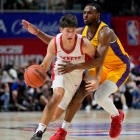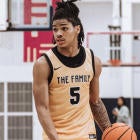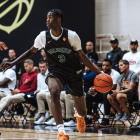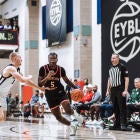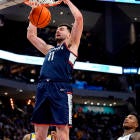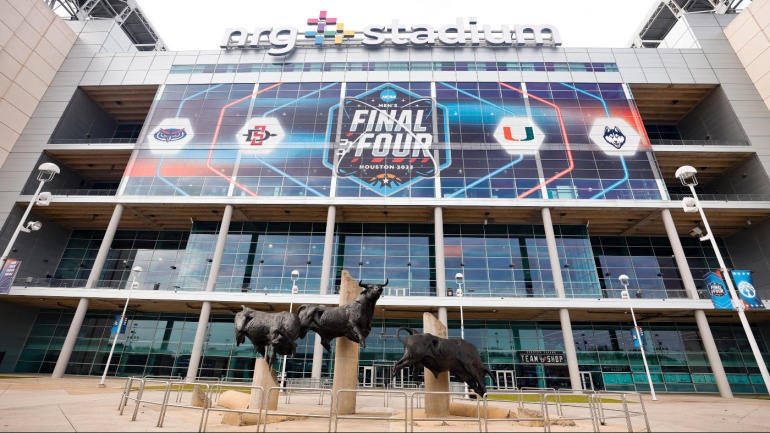
An absolutely epic 2023 NCAA Tournament has reached the point where we turn our attention to the game's biggest stage, the Final Four. NRG Stadium in Houston will play host to an edition of the Final Four that already stands out as historically notable before we've even tipped off the early game on Saturday.
This is the first time since seeding began in 1979 that no teams from the No. 1, No. 2 or No. 3 seed lines have made it to the Final Four and just the fourth time that no there won't be an No. 1 seeds in the Final Four (1980, 2006, 2011). This year features three teams all making their Final Four debut (FAU, San Diego State, Miami), making this the first year with three "first-timers" since 1970.
But what about the teams, the players, strengths, weaknesses and what to expect from all four teams when they hit the floor on Saturday night? We've got that, and more, covered for you below in our team-by-team breakdowns to get you ready for the semifinals of the NCAA Tournament where it will be No. 5 seed San Diego State vs. No. 9 seed FAU followed by No. 4 seed UConn vs. No. 5 seed Miami on Saturday night in Houston.
(5) San Diego State Aztecs
Much was made in last year's Final Four about how Kansas' title run had some ties to the opportunity that was lost with the cancellation of the 2020 NCAA Tournament. While Kansas was potentially headed to being the No. 1 overall seed in that field, the same missed opportunity storyline exists here with Brian Dutcher and San Diego State.
The Aztecs were 30-2 when the tournament was canceled, rated in the top-15 nationally in offense and defense and were likely headed to a No. 2 seed in the bracket. Keshad Johnson, Adam Seiko, Nathan Mensah and Aguek Arop were all on that team, and while it's not a dominant storyline within the program the way this group has seized on the opportunity presented in 2023 is notable. We'll never know if Dutcher and that 2020 team would have made the Final Four, but now the "what if" doesn't sting as much with the Aztecs making program history this season.
In terms of San Diego State's ceiling, this is a team that can win the national championship if games are played on their terms. No one in the Final Four is better defensively, no one in the Final Four plays at a slower pace and none of the other teams remaining have as much cumulative Division I experience (per KenPom.com) as the Aztecs. The confidence and toughness levels for this San Diego State team are through the roof right now, so if the games are low-scoring and come down to intangibles this is a group that can cut nets in Houston.
- Record: 31-6
- Final Four appearances: 1 (2023)
- NCAA titles: 0
- NCAA Tournament path: First round – Def. No. 12 Charleston 63-57; Second round – Def. No. 13 Furman 72-52; Sweet 16 – Def. No. 1 Alabama 71-64; Elite Eight – Def. No. 6 Creighton 57-56 to win South Regional.
- Coach: Brian Dutcher is in his first Final Four as a head coach but he is all too familiar with this stage, having been a top assistant for Steve Fisher during the national championship run at Michigan in 1989 and the back-to-back Final Four runs of 1992 and 1993 with the Fab Five. Dutcher made the move to San Diego State with Fisher and in his six years since being promoted to head coach he's led the Aztecs to three regular season conference titles, three conference tournament titles and an NCAA Tournament appearance in four of the last five tournaments. He had not, however, gotten his first NCAA Tournament win until 2023, but now he's got four wins in the big dance and owns the honor of leading a quality San Diego State program to its first-ever Final Four.
- Best Player: Darrion Trammell. There are a lot of options here in the Aztecs backcourt, but we'll go with the guard who had a game-high 21 points in the takedown of No. 1 overall seed Alabama and then knocked down the game-winning free throw against Creighton in the Elite Eight. Trammell is a transfer from Seattle who has played bigger than his 5-10 frame in key moments, not just on offense but as one of the team's best perimeter defenders. He and fellow guard Lamont Butler were outstanding during the second weekend, and if Matt Bradley – the team's scoring leader on the season at 12.5 points per game – is able to recapture his best form this will be one of the toughest backcourts to deal with in Houston.
- Strengths: San Diego State is elite defensively, with an adjusted efficiency rating that currently sits at No. 4 nationally, but it's worth pointing out that the Aztecs have been uniquely locked in during this postseason run. Since the start of the Mountain West Tournament, San Diego State has held opponents to just 56.6 points per game, with only two of their seven opponents breaking 60 points and none getting to 65.
- Weaknesses: While being one of the best defensive teams in the entire country, San Diego State is not a particularly elite shooting team. The Aztecs have been solid on the offensive glass to make up for those stretches when the jumpers are not falling, and their depth has helped keep bodies fresh late into games. But if an opponent can keep San Diego State's frontcourt off the glass this is not a team that can out-shoot its opponent.
- Key number: 17%. The 3-point defense – which ranks No. 2 in the nation on the season – has been an X-factor for San Diego State here in the NCAA Tournament, helping secure wins against four opponents who either shoot a lot of threes and/or can make them at a high clip. Charleston, Furman, Alabama and Creighton combined to go 16-for-94 (17%) from behind the arc and in the second weekend Creighton and Alabama had just five made 3-pointers combined.
(9) FAU Owls
FAU has the longest betting odds to win the national championship and it's trying to become the first team ever to even advance to the national championship game after making the Final Four as a No. 9 seed or worse. The historical precedent in the NCAA Tournament says Cinderella runs like this come to a close in the national semifinals, but FAU is not beholden at all to historical precedent. It doesn't even have that much history of its own, founding the men's basketball program in 1988 at the Division II level before making the jump to D-I in 1993. Holding historical precedent as the reason why FAU can't win one, or two games in the Final Four ignores everything that the Owls have been here in the present.
FAU has played 38 college basketball games this season and won 35 of them, with the only three losses coming in true road environments by 13 points or less. The Owls may be from Conference USA but they've got a 2-1 record against the SEC and just took down the third-place team from the Big 12. This is a team that's played seven games against top-50 teams at KenPom and won six of them, so there's absolutely a path for FAU to rattle off two more victories against quality competition. That said, accomplishing that feat would make FAU one of the most unlikely champions in college basketball history. It could happen, but it's not the projected outcome.
- Record: 35-3
- Final Four appearances: 1 (2023)
- NCAA titles: 0
- NCAA Tournament path: First round – Def. No. 8 Memphis 66-65; Second round – Def. No. 16 Fairleigh Dickinson 78-70; Sweet 16 – Def. No. 4 Tennessee 62-55; Elite Eight – Def. No. 3 Kansas State 79-76 to win East Regional
- Coach: A former student manager at Indiana, Dusty May has worked his way up the ranks in the coaching world through more than a decade of being an assistant at Eastern Michigan, Murray State, UAB, Louisiana Tech and Florida. First named the head coach at FAU back in 2018, it's been a building process to get the Owls to this point where they are making program history. FAU won 17, 17, 13 and 19 games, respectively, in May's first four seasons before the 35-win explosion that we've seen in 2023.
- Best Player: Johnell Davis. This is a deep and balanced rotation with a couple players that could be highlighted, but few players have commanded the spotlight in this tournament like the third-year sophomore from Gary, Indiana. Davis is the team's leading scorer on the season at 13.9 points per game and in the NCAA Tournament he's averaging 17.3 points, 7.8 rebounds, 3.3 assists and 1.5 steals per game. But while Davis, an undersized forward, has been the team's star, we also saw a breakout showing from 7-1 sophomore Vladislav Goldin in the second weekend. Goldin, a third-year player from Russia who started his career at Texas Tech, was named to the East Region All-Tournament team along with Davis after putting up 14 points and 13 rebounds in the Elite Eight win against Kansas State.
- Strengths: This is a deep, athletic and energetic team that utilizes those advantages on both sides of the floor. Offensively it's all about pace and space, getting up a lot of three-point attempts and keeping defenses off-balanced with multiple ball handlers capable of initiating offense. Defensively FAU is not afraid to extend pressure to half court or beyond, again relying on fresh legs from the deep rotation to wear down opponents and also prevent transition opportunities.
- Weaknesses: On the season, FAU shoots 3-pointers more often and relies on made 3-pointers for its production more than any other team in the Final Four. The concern is that in this tournament, the Owls have been shooting below their season standard from behind the arc. FAU's season average of 36.5% on 3s has dropped to 31.2% in the tournament, yet the amount of 3s taken has remained on pace with season averages. With the move to a football stadium disrupting sight lines and a national semifinal opponent who is elite at 3-point defense, the recent form from deep is a valid concern.
- Key number: 9. FAU has nine players who average at least 15 minutes per game and those nine players have all seen significant NCAA Tournament action in the Owls' four wins. KenPom has FAU ranked as the No. 15 team in the country in bench minutes, which stands out as the highest ranking for any team in the field of 68. Dusty May's substitution patterns can sometimes look like line changes, but it's that commitment to depth that serves as protection against foul trouble, minor injuries and fatigue.
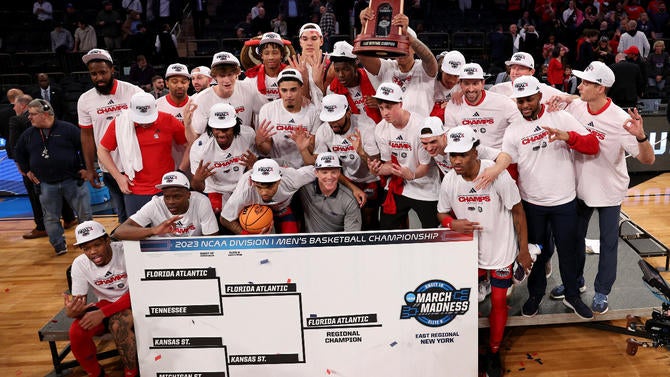
(5) Miami Hurricanes
If Miami can get past UConn on Saturday night, it's going to be in a great position to win the program's first national championship. The issue of course being that the Huskies are not only the betting favorite to win it all but present some unique matchup challenges for the Hurricanes to address. That said, there is not another team in this Final Four that has the high-end offensive ceiling of Miami, and if you are going to name one group that could have a historically great shooting performance in Houston it's going to be this lineup with Isaiah Wong, Nijel Pack and Jordan Miller leading the way.
While Norchad Omier plays so much bigger than his listed 6-7, it's asking a lot for him to overcome the size differential against both Adama Sanogo and the 7-2 freshman Donovan Clingan. They had success against Trayce Jackson-Davis in the second round, but beyond that win against Indiana the rest of the Hurricanes' tournament path has not presented many players with an impact post presence like what UConn will present on Saturday night. But again, if Miami can win that first game it's got more offensive skill than both San Diego State and FAU. So the outlook for what the Hurricanes can accomplish in the Final Four really comes down to what happens on Saturday night.
- Record: 29-7
- Final Four appearances: 1 (2023)
- NCAA titles: 0
- NCAA Tournament path: First round – Def. No. 12 Drake 63-56; Second round – Def. No. 4 Indiana 85-69; Sweet 16 – Def. No. 1 Houston 89-75; Elite Eight – Def. No. 2 Texas 88-81 to win Midwest Regional
- Coach: Jim Larranaga is making his second Final Four appearance 17 years after guiding George Mason to his stage in one of the all-time Cinderella runs. This run with Miami has been less of a shooting star and more of a product of his work with the program since arriving in 2011. In 12 seasons, Larranaga has guided the Hurricanes to six NCAA Tournament appearances with four trips to the Sweet 16. This is a program that had just four NCAA Tournament wins all-time prior to Larranaga's arrival and he's added 11 more to the school's tally. At 73 years old, Larranaga has not taken this Miami job as an opportunity to sail off into the sunset but instead reinvented in his process multiple times over to adapt to a changing landscape in the sport.
- Best Player: Jordan Miller. Any one of Miami's starting five has the ability to be the best player in any given game, but we'll focus on the player who displayed near perfection in his performance against Texas in the Elite Eight. The 6-7 senior, who started his career at George Mason interestingly enough, had 27 points on 7-for-7 shooting from the field and a 13-for-13 showing at the free-throw line against the Longhorns. It was the most points in an NCAA Tournament game with no missed shots since Christian Laettner in the Elite Eight against Kentucky back in 1992, and though Miller did not have a singular highlight to compare to "The Shot," he has strung together a series of big performances in key moments throughout the season. Game-changing guard Isaiah Wong, Kansas State transfer Nijel Pack, emerging star sophomore Wooga Poplar and the force down low that is Norchad Omier have all had moments of greatness, but Miller's star can shine the brightest when it counts the most.
- Strengths: The real power of Miami's versatility is showcased on the offensive end where the Hurricanes are one of the most lethal scoring teams in the entire country. The Hurricanes' offensive efficiency is up to No. 5 in the entire country, per KenPom, and basically since the near-upset to No. 12 seed Drake in the first round it's been nothing but buckets ever since. Miami scored 85 points against Indiana in the second round, 89 points against Houston in the Sweet 16 and 88 points against Texas in the Elite Eight, with those last two victories coming against teams that ranked among the top defenses in the entire NCAA Tournament field. With four different players averaging double-digit scoring you can't scheme to stop just one or even two guys, and the way Miami has outplayed opponents in the second half shows its ability to adjust the way it attacks within the game.
- Weaknesses: For all its offensive ability, this is a team which has a glaring weakness on the defensive end. Toughness, effort and athleticism can make up for what's been a season-long trend of average defense – Miami ranks No. 104 in adjusted defensive efficiency, while the other Final Four competitors all rank inside the top 30 – but when considering the Hurricanes' national semifinal opponent it is going to take outperforming the season standard to take down UConn. Teams that move the ball well and can apply pressure in the post have given Miami's defense trouble this year, and UConn checks both of those boxes emphatically.
- Key number: +46. Miami is not an especially deep team, but in this tournament the Hurricanes have finished remarkably better than their opponents. The cumulative first half score differential across Miami's four tournament wins is -2, while the cumulative second half score differential is +46. The Hurricanes outscored Drake by 12, Indiana by 11, Houston by 8 and Texas by 15 points in the second half, twice overcoming halftime deficits and each case answering the moment with shots and stops in key possessions down the stretch.
(4) UConn Huskies
The easy summary to all of the aforementioned praise for this UConn team is that the Huskies were closer to being the 4th best team in the entire country than they were to being a No. 4 seed as ranked by the selection committee. UConn being in this position is not only much less surprising than the other three Final Four participants, but it's an outcome that oddsmakers were willing to consider as a decent possibility even after the Huskies got placed in the tournament's toughest region.
There were nine teams with title odds of 20-1 or better after the field was announced, and four of those nine teams were in the West Region. UConn in any other region would have been considered even more likely to win the national championship, but even the tough road it faced had the Huskies among the nine most likely options to win it all. But oddsmakers don't determine titles, and being the pre-Final Four favorite does not put the scissors in your hands to cut down the nets. UConn faces an extremely tough challenge in slowing Miami's electric offense in the national semifinal, and if it wins that game it will either face one of the country's best defensive teams or a deep and energetic FAU squad on the verge of making all-time tournament history.
There is tons of evidence and support from experts to say the outlook for UConn is a fifth national championship, but there's still just enough uncertainty to have us tuning in to see if the Huskies can get it done.
- Record: 29-8
- Final Four appearances: 6 (1999, 2004, 2009, 2011, 2014, 2023)
- NCAA titles: 4 (1999, 2004, 2011, 2014)
- NCAA Tournament path: First round – Def. No. 13 Iona 87-63; Second round – Def. No. 5 Saint Mary's 70-55; Sweet 16 – Def. No. 8 Arkansas 88-65; Elite Eight – Def. No. 3 Gonzaga 82-54 to win West Regional
- Coach: Dan Hurley is making his first Final Four appearance as a head coach in his fifth NCAA Tournament appearance, leading Rhode Island to the big dance twice (2017, 2018) in addition to this three-year run with UConn (2021-23). The youngest son of New Jersey high school basketball legend Bob Hurley and brother to former Duke star and current Arizona State head coach Bobby, Hurley has built UConn up to this breakthrough moment in 2023. It was a rough start to his tenure, with a 16-20 conference record across his first two seasons, but since joining the Big East the Huskies have taken a jump both locally and nationally. UConn has a 37-19 record (.661 winning percentage) in Big East play over the last three years, and made it back to the NCAA Tournament after a five year – and four tournament absence – that had lingered since 2016.
- Best Player: Adama Sanogo. There's a good argument for Jordan Hawkins, the First Team All-Big East performer who was just named the Most Outstanding Player in the West Regional after dropping 44 points (and 9 made three-pointers) combined in the wins against Arkansas and Gonzaga. But a proper focus of individual excellence has to rest on junior big man Adama Sanogo. No one in the Final Four has scored more points in this tournament (80) than Sanogo, and he's also averaging 9.8 rebounds per game and shooting 66% from the field. Sanogo was the Big East's leading scorer on the season, and UConn is 19-0 when he has scored 20+ points throughout his career. Other Huskies on this well-balanced lineup can be difference-makers, but the barometer for UConn's success is Sanogo.
- Strengths: UConn has more high-level pieces that fit together well than any team in the country, and that's been the case most of the year. The Huskies' balance up and down the lineup is the team's greatest strength, with Sanogo able to dominate around the rim and Hawkins providing elite playmaking on the perimeter. This is one of the best offensive rebounding teams in the entire country and one of the best teams in the NCAA Tournament field when it comes to offensive ball movement to set up easy buckets. Many of those same strengths also help UConn rate as a top-15 defensive team, including the team's size and length. They are physically imposing on the perimeter and inside, and make an effort to chase teams off the three-point line and funnel action into the middle where Sanogo holds down things at the rim. From offense to defense, inside to outside, this is just a complete team.
- Weaknesses: UConn started the season 14-0 with 13 double-digit wins, including a 15-point win against Alabama, and then finished the year going 13-2 over its final 15 games. So what happened in between during that 2-6 stretch from Dec. 31 to Jan. 25 that we can examine to expose a weakness? Two things that UConn opponents did to find success during this time were to limit the Huskies transition opportunities and apply aggressive ball pressure to a backcourt that lacks a traditional point guard. The problem of course is that Hurley has made adjustments to these weaknesses, particularly on offense, as the offense now will flow sometimes through forward Andre Jackson, who has racked up 31 assists through four games here in the tournament.
- Key number: 19. UConn has won 19 games by 15 or more points this season, which is tied for the most in the country. Each of the four tournament wins has counted towards this total, beating teams by an average of 22.5 points per game.










